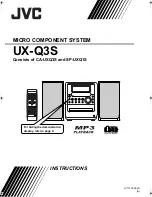
9(16)
Disconnecting the hydraulics:
Before disconnecting the fittings, lower the attachment on solid and level surface. Turn the control lever of
the auxiliary hydraulics to its neutral position.
When removing the attachment, always disconnect the hydraulic couplings before
unlocking the quick attach plate, to prevent hose damage and any oil spills. Reinstall
the protective caps on the fittings to prevent impurities from entering the hydraulic
system.
Releasing residual hydraulic pressure:
In case residual pressure is left in the hydraulic system of the attachment, it is often possible to disconnect
the hydraulic couplings, but it may be difficult to connect them the next time. If the fittings will not connect,
the residual pressure must be released by turning the auxiliary hydraulics control lever of the loader, when
the engine is turned off. To make sure that there will not be residual pressure in the hydraulic system of the
attachment, shut down the loader engine and move the auxiliary hydraulics control lever of the loader before
disconnecting the couplings.
6.
Instructions for use
Once the concrete mixer bucket and its hydraulic hoses have been attached according to the instructions, it
is ready for work. Read the following instructions about work site, setting up, use and maintenance of the
concrete mixer.
Never go under a raised boom or concrete mixer component. Note that the loader
boom can be moved even if the engine has been stopped.
Check the attachment and the operating environment once more before starting the machine. Quick
inspection of the concrete mixer and the operating environment prior to use are a part of ensuring safety and
the best performance of the equipment.
•
Choose a level working site, which can carry the load of the equipment.
•
Operate the concrete mixer in daylight or in good artificial light and in well ventilated areas. All
obstacles around the bucket must be removed. Remember correct working methods and avoid
getting down unnecessarily from the loader.
•
Transport the mixer carefully and note the effect of weight at the front to the stability of the loader.
•
Make sure that the parking brake of the loader is engaged and that the attachment is supported on
the ground, so that it can not move when loading material by hand.
•
Check that the concrete mixer is intact and remove any material left in the bucket before starting the
mixer.Check that the mixing shaft can rotate freely and that there is no material coiled around the
shaft.
•
Check regularly to ensure there are no hydraulic leaks. Refer to chapter 7 for maintenance
instructions.
•
Ensure that the loader and the attachment are used in a safe and intended manner. Do not allow
children to operate the equipment.
•
Do not go near the equipment when another person is operating the loader controls.
Avoid hazards of crushing and being overrun by
ensuring that the loader parking brake is engaged.
Use the equipment only on level surfaces and
make sure that the equipment will stay still
regardless of the possible movements caused by
the mixer.


































